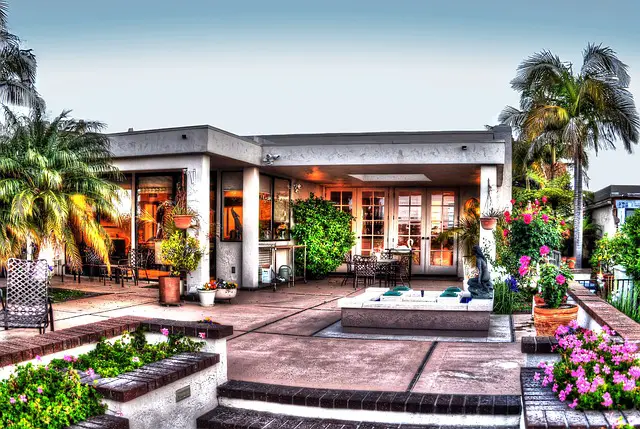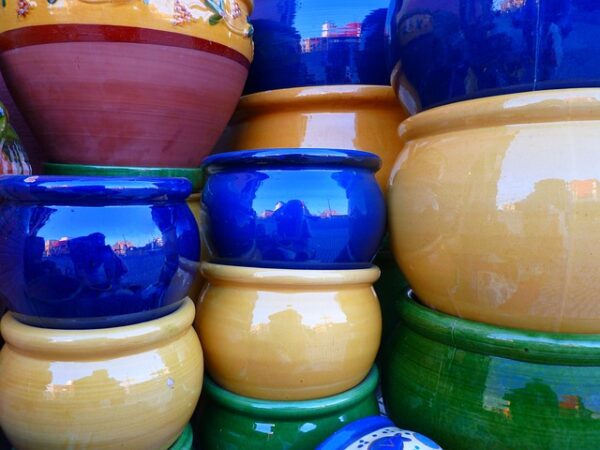
Creating A Small Dream Patio Garden
Gardens on porches and patios can provide a colorful accent to almost any decor. They can make a place feel natural and inviting. Many people enjoy lingering in a garden filled with healthy, vibrant plants.
Anyone with a patio can have a small patio garden! You may find it surprisingly easy to create. A patio garden can enhance the beauty of your home and give you a fine place to relax. It may also provide your table with herbs and spices or fresh produce.
Plan Your Patio Garden
The first step to creating a small patio garden is to plan! Creating a garden of any size can present some difficulties. It requires dedication and foresight, and the willingness to try and fail. For every exotic den of greenery, there are dozens of apocalyptic patio wastelands. However, with the right plan and tools, you can create a flourishing patio garden to enjoy all season long!
Plant Pots & Containers
Pots
Plant pots and containers come in all styles and colors with varying characteristics. Different pot sizes offer flexibility when moving plants and dealing with challenging spaces. It’s important to plan a patio garden with the number of plants you can handle. To further increase your chance of success with your patio garden, you can even find plant grow kits with many different features that you may find useful, such as automatic watering systems to help simplify your watering chore.
Pots can be placed on benches and railings. They can also be put on walls, the floor, or suspended in baskets. You can put them on furniture, wooden planks on cinder blocks, or plant stands.
Plastic pots are lightweight and durable and help retain water. Being lightweight can be a drawback if the plant is large enough to make it top-heavy if the soil goes dry. A light breeze could tip it over. This might cause the pot and plant to roll around on the floor. You could walk out to your patio and find a root ball, an empty pot, and a loose pile of dirt.
Glazed ceramic pots are popular for aesthetic reasons and retain water longer than unglazed pots. Glazed or unglazed ceramics can be heavy, which can be an advantage. Before buying any ceramic pot, look for a drainage hole or holes. You can’t add a hole later without special equipment.

Image by LoggaWiggler from Pixabay
Planters
Planters are big pots that sit on the floor. They might be pottery, metal, wood, or plastic. They could be waist-high and contain a small biome or just one or two large plant specimens.
Planters can be heavy. They can get heavier if they fill with rainwater. That much weight could destroy patio decking or cause the planter to burst. So, it’s important to choose the right planter for your space.
Plant Beds Or Trays
Plant beds or trays are typically raised rectangular platforms, sometimes on wheels. They are usually made of lightweight material. Beds are the preferred solution for many who want to grow consumable crops.
Plant beds can be simple or complex. Some include a basic tray of soil on a cart, and others provide automatic watering features, humidity sensors, timers, grow lights or even an app.
Beds have the advantage of size and efficiency in their favor. They can be perfect for a wide variety of herbs and microgreens. Some plant beds are designed to grow only a specific type of plant.
Soil
Unless you have access to clean soil free of fungus, chemical contamination, and invertebrate hitchhikers, you’ll need to buy it. You’ll find it in bags, clean and possibly optimized for your type of plants, at home improvement stores and garden centers.
Grabbing some soil from an empty lot may be tempting, but it’s not a good idea. This type of soil may be contaminated. It may be loaded with chemicals, bacteria, mold, or all of the above. So, it’s best to choose store-bought soil to avoid these potential issues.
Sunlight
Plants do best when you put them in a suitable environment. Sunlight is a primary consideration.
Plants For Full Sun
Full sun is direct sunlight for at least six hours. Aside from obvious choices like a cactus, plants that like to bake in the sun include:
Helianthus – Sunflowers have many advantages. While you may not want one of the giant specimens in a small garden, there are plenty of dwarf varieties that provide bursts of colorful blooms. These varieties include Firecracker, Elf, Sundance Kid, and more.
Aloe – Aloe Vera is well known to anyone who uses skin care products. The moisturizing gel that fills the spiky leaves of this plant may provide more than just hydration. Like many botanicals, aloe has been studied for various benefits. Once established, most aloe species require little care.
Basil – This popular, multi-use herb loves the sun as much as it loves water, so make sure to give it both. Most species have bright green leaves. Basil does well in plant beds, where you might pamper it by keeping it out of the wind.
Plants for Medium Sun
This category includes anywhere that has less than 4 hours of direct sunlight. These areas can switch rapidly from hot and dry to cold and wet, and either extreme may spell doom. It is impossible to tell which plant will work best in this situation, but here are some good candidates.
Black Eyed Susan – These hardy and easy-to-cultivate perennials can handle the occasional hot afternoon. There are several varieties, from the standard yellow flower with the black center (Rudbeckia Hirta) to variegated shades of orange and cherry red.
Columbine – This hardy plant is a perennial, so it is a good choice for immovable planters and ground plots. Many different kinds of columbine, including dwarf varieties, bloom in different colors.
Begonias – These plants are hardy, and some varieties bloom throughout the summer. With more than 2000 members in the Begoniaceae family of plants, you will find one that fits your patio garden. If you want to research specific varieties, the American Begonia Society is there to help.
Image: https://pixabay.com/photos/house-patio-luxury-wood-seat-3346909/
Plants For Low Sun
These areas never get direct sunlight; if they do, it’s brief. Many plants have adapted to this environment.
Heuchera – Coral Bells are very popular shade-tolerant plants. They are wide varieties with colorful foliage. Their blooms can be white, red, and pink, with many variations, and hummingbirds love them. Coral Bells are hardy and not particular about soil quality.
Lamium – This plant, or Dead Nettle, is a fast-growing ground cover that thrives in many different soil conditions. It likes the shade and grows quickly to fill available space. It has diversified yellow, white, or bright green leaves and blooms in flower clusters of white, pink, or purple.
Impatiens – This is a go-to plant for many gardeners dealing with a shade-rich environment. Impatiens are hardy and fast-growing. They grow wild in parts of Africa, Asia, and North America. Blooms come in various colors: white, yellow, red, and purple.
Deep Shadow
Secluded corners and areas under overhanging architecture or tree limbs fit this description. They never get much sunlight so they might be plagued with recurring mildew or mold. While these areas may seem unlikely for gardens, they present unique opportunities for outside-of-the-box gardeners.
Moss – Moss can grow on tile, wood, concrete, or stone. Collect it from nature. Don’t let it dry out during transit. Place it on a bed of gravel, stones, or sculpture, and keep it well watered. The key to moss gardens is high moisture content, so don’t be afraid to overwater.
Carnivorous plants – Venus Fly Traps, sundews, and pitcher plants may do well in this environment. However, they can be very demanding and may not be the best choice for beginners.
Mushrooms – Mushroom gardens are getting popular due to the wide variety of mushroom-growing kits on the market. Start with a kit and see what happens. If they flourish, you’ll have a great source of fresh mushrooms for the kitchen.
To make maintenance of this area easier, keep these gardens off the floor. Don’t let your garden touch the walls. That way, you can mop and treat for mildew growth, for example, without poisoning your garden with disinfectants.
Trial, Error, & Common Sense
Every successful gardener has had some failures in the past. Be attentive when you start your patio garden. Do some research on your plants. Inspect them closely for wilting, limp leaves and stems, spotting, color changes, and other signs that indicate poor plant health. Be ready to move them to new locations, if necessary, until they find a place to thrive.
A lot of gardening skill comes from learning the needs of your plants and exercising common sense. Every failure is a learning experience. Most plants will thrive with the right amount of sunlight, water, and occasional fertilizer, and your small patio garden will look awesome throughout the year.
